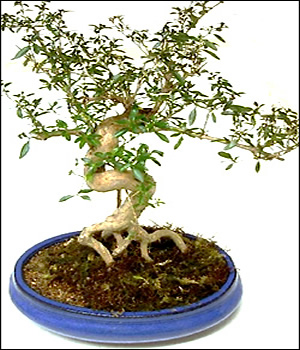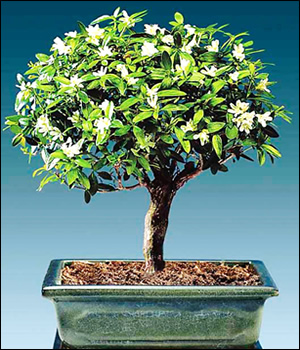Serissa is a genus of flowering plants in the family Rubiaceae. It is native to open sub-tropical woodlands and wet meadows in south-east Asia, India, and China to Japan. It is commonly called the” snowrose”, “Tree of a Thousand Stars”, or “Japanese boxthorn” and was previously called Serissa foetida. 'Foetida' means unpleasant odour, that the trees give off if their leaves are pruned or bruised. Snowrose and tree of a thousand stars are different cultivars. The only method of differentiating is measuring the difference in the shape and size of the flowers
It is an evergreen or semi-evergreen shrub, 45 – 60 cm high with oval, deep green, rather thick leaves. The upright stems branch in all directions and form a wide bushy dome. It is grown for its neat habit, good coverage of branches and long flowering time. It is also valued for its rough, grey trunk which tends to get lighter in colour with age.
Serissa flowers practically all year round, from early spring to near autumn. The 4- to 6-lobed flowers are funnel-shaped and 1 cm wide. They first appear as pink buds but turn to a profusion of white flowers.
Serissa is one of the most popular bonsai sold as indoor bonsai. It is not difficult to maintain as bonsai, but is very fussy. Many beginner bonsai enthusiasts will lose a Serissa due to their being less than knowledgeable to care for it. The trees respond badly by dropping leaves if over-watered or under-watered, if it is too cold, too hot, or even if just moved to a new location. The plant usually comes back to health when given better conditions. They will not survive outside. Serissa bonsai do not tolerate frost and needs temperatures between 50° F / 10° C and 68° F / 20° C in winter.
The heart of the problem with this species is the difficulty in maintaining the humidity levels required by Serissa in an indoor environment and this frequently causes the tree to suffer.
For indoor care; when temperatures drop below 7°C (day or night) find a bright but not permanent position out of cold draughts, on an east or west facing windowsill. Good humidity levels must be maintained and can be provided by the use of a tray of grit beneath the tray, keep the grit moist at all times. Never place the tree on a windowsill above a radiator. Central heating is the primary reason that indoor cultivation proves difficult as it dries the air. Do not place the tree on a windowsill where the curtains are closed at night as this environment can produce very cold temperatures at night during winter.
Moving the tree to a new position will stress the tree until it acclimatizes, on occasions causing yellowing and dropping leaves. It should be followed within a few days by fresh growth. They are not easy to keep growing well.
The main reason so many are sold by Garden Centres is that people blame themselves and keep buying another tree to try again!





Pruning and wiring
Serissa tolerates hard pruning and it should be done in early spring. Young trees are trimmed back to two leaves when the shoots have produced 4 – 5 leaves. Older trees are trimmed less while they are flowering, but are pruned thoroughly after flowering. Every two or three years the branches must be cut back to old wood in order to keep the tree shape compact. Branches and shoots can be wired at any time, but they are brittle and must be wired with great care. Remove the wire after approximately six months before it cuts into the bark.
Web design: nysys